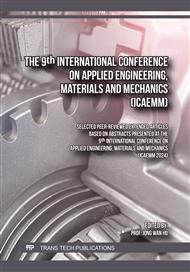[1]
Y. Wang, J. Yi and Y. Xia, Recent progress in aqueous lithium‐ion batteries, Adv. Energy Mater. 2 (2012) 830-840.
DOI: 10.1002/aenm.201200065
Google Scholar
[2]
J.B. Goodenough and Y. Kim, Challenges for rechargeable batteries, J. Power Sources 196 (2011) 6688-6694.
DOI: 10.1016/j.jpowsour.2010.11.074
Google Scholar
[3]
M. Armand and J. M. Tarascon, Building better batteries, Nature 451 (2008) 652-657.
DOI: 10.1038/451652a
Google Scholar
[4]
P. G. Bruce, S. A. Freunberger, L. J. Hardwick and J. M. Tarascon, Li-O2 and Li-S batteries with high energy storage, Nat. Mater. 11 (2012) 19-29.
DOI: 10.1038/nmat3191
Google Scholar
[5]
X. Huang, X. Guo, H. Tang, J. Zhang, Q. Tang, H. Yang, L. Wang and X. Zhao, Effect of electrolyte concentration on performance of lithium-sulfur batteries, J. Power Sources 359 (2017) 208-214.
Google Scholar
[6]
M.M. Thackeray, C. Wolverton and E. D. Isaacs, Electrical energy storage for transportation—approaching the limits of, and going beyond, lithium-ion batteries, Energy Environ. Sci. 5 (2012) 7854-7863.
DOI: 10.1039/c2ee21892e
Google Scholar
[7]
D. Aurbach, E. Zinigrad, Y. Cohen and H. Teller, A short review of failure mechanisms of lithium metal and lithiated graphite anodes in liquid electrolyte solutions, Solid State Ionics 148 (2002) 405-416.
DOI: 10.1016/s0167-2738(02)00080-2
Google Scholar
[8]
J.M. Tarascon and M. Armand, Issues and challenges facing rechargeable lithium batteries, Nature 414 (2001) 359-367.
DOI: 10.1038/35104644
Google Scholar
[9]
N. Nitta, F. Wu, J. T. Lee and G. Yushin, Li-ion battery materials: present and future, Mater. Today 18 (2015) 252-264.
DOI: 10.1016/j.mattod.2014.10.040
Google Scholar
[10]
K. Xu, Nonaqueous liquid electrolytes for lithium-based rechargeable batteries, Chem. Rev. 104 (2004) 4303-4417.
DOI: 10.1021/cr030203g
Google Scholar
[11]
W. Xu, J. Wang, F. Ding, X. Chen, E. Nasybulin, Y. Zhang and J. Zhang, Lithium metal anodes for rechargeable batteries, Energy Environ. Sci. 7 (2014) 513-537.
DOI: 10.1039/c3ee40795k
Google Scholar
[12]
D. Lin, Y. Liu and Y. Cui, Reviving the lithium metal anode for high-energy batteries, Nat. Nanotechnol. 12 (2017) 194-206.
DOI: 10.1038/nnano.2017.16
Google Scholar
[13]
M.D. Tikekar, S. Choudhury, Z. Tu and L. A. Archer, Design principles for electrolytes and interfaces for stable lithium-metal batteries, Nat. Energy 1 (2016) 16114.
DOI: 10.1038/nenergy.2016.114
Google Scholar
[14]
Y. Li, W. Yang, X. Li, Z. Wu, J. Xie, Y. Deng, S. Zhang and J. Wang, Long-cycle and high-rate lithium-metal batteries enabled by a rigid and stretchable polymer-electrolyte interphase, Adv. Mater. 30 (2018) 1800389.
Google Scholar
[15]
C. Monroe and J. Newman, Dendrite growth in lithium/polymer systems: a propagation model for liquid electrolytes under galvanostatic conditions, J. Electrochem. Soc. 150 (2003) A1377-A1384.
DOI: 10.1149/1.1606686
Google Scholar
[16]
X.-B. Cheng, R. Zhang, C.-Z. Zhao, F. Wei, J.-G. Zhang and Q. Zhang, A review of solid electrolyte interphases on lithium metal anode, Adv. Sci. 3 (2016) 1500213.
DOI: 10.1002/advs.201670011
Google Scholar
[17]
C. Liu, F. Li, L.-P. Ma and H.-M. Cheng, Advanced materials for energy storage, Adv. Mater. 22 (2010) E28-E62.
Google Scholar
[18]
J. B. Goodenough, Y. Kim, Challenges for rechargeable batteries, J. Power Sources 196 (2011) 6688-6694.
DOI: 10.1016/j.jpowsour.2010.11.074
Google Scholar
[19]
A. Manthiram, J. C. Knight, S.-T. Myung, S.-M. Oh and Y.-K. Sun, Nickel-rich and lithium-rich layered oxide cathodes: progress and perspectives, Adv. Energy Mater. 6 (2016) 1501010.
DOI: 10.1002/aenm.201501010
Google Scholar



